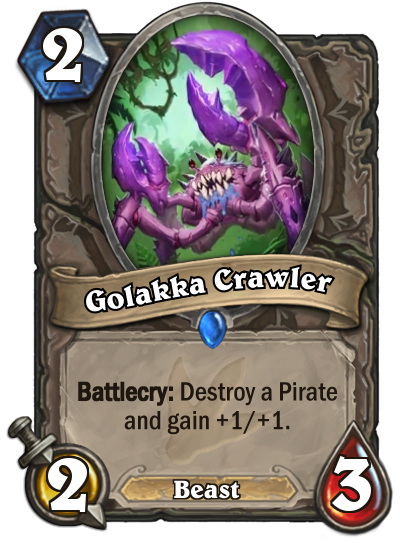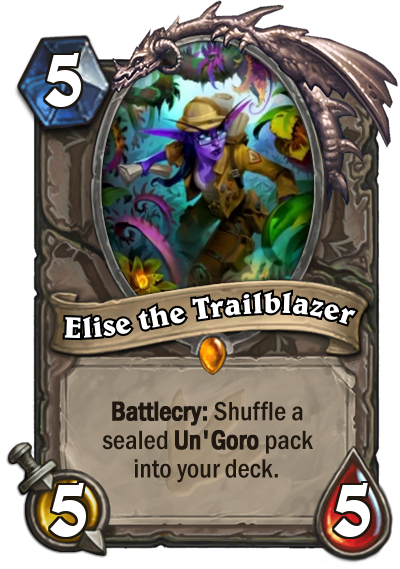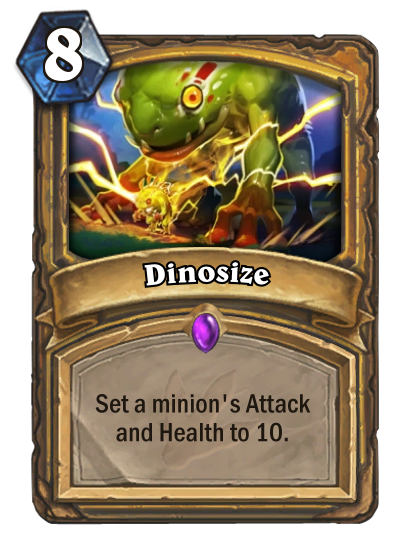Last week, Blizzard hosted a live stream where they revealed eleven of the new Journey to Un’Goro cards. The stream was presented by Peter Whalen, a senior game designer, and Day9, a popular streamer and caster. Day9, who recently launched a popular video series about learning to play Dota, pressed Whalen for answers about Blizzard’s approach to designing Hearthstone cards. Somewhat surprisingly, Whalen answered every question directly. There was no dancing around ‘sensitive’ topics, and the stream gave Hearthstone players a fascinating look into how the game’s developers approach the process of card creation. It also cleared up a lot of misconceptions that many players, myself included, may have had.
Card Design Timeline
The timeline for card creation is often talked about in the community, but these discussions are mostly speculative, since Blizzard has provided very little concrete information. Until now. It was often assumed that the developers were working on cards many months before release, which led many to believe that the developers weren’t reacting to current issues. Some thought that the cards were finished months ahead of time and left untouched, as the next set was started. In fact, early on in this stream Whalen commented on that exact thing. He said that Journey to Un’Goro was a passion for many of the developers, and that they had been working on it for almost a year. He said Journey to Un’Goro was started just after Whispers of the Old Gods was released.
However, Day9 cleared up some misconceptions later in the stream. When Golakka Crawler was revealed, Day9 commented that he was surprised the card was made a year ago, since it seemed like it was an answer to the current meta. Whalen replied that this particular card was added “pretty late.” He said that Blizzard often leaves several slots open when designing an expansion for exactly that reason: they want to make sure they’re able to add cards that respond to the meta.
Golakka Crawler, Whalen noted, was actually adapted from a different card. The card originally was a larger crab that read “Destroy a Murloc and gain +4/+4.” With the way the meta was shaping, they decided it was better this way, so they adapted it. This says a lot about their willingness to accept problems and change their cards, at least in development.
You May Like
Minor Tweaking
Another topic that Day9 and Whalen talked about is the idea of “” tweaking” luck. Elise the Trailblazer was revealed last week, and she shuffles a Journey to Un’Goro pack into your deck. When discussing it, Whalen admitted that an average Un’Goro pack was “actually kind of weak in the context of a game.” Rather than leave it in that state, they adjusted the modifiers and made Elise extremely lucky. Her pack has one legendary on average, and is guaranteed at least an epic every time.
tweaking” luck. Elise the Trailblazer was revealed last week, and she shuffles a Journey to Un’Goro pack into your deck. When discussing it, Whalen admitted that an average Un’Goro pack was “actually kind of weak in the context of a game.” Rather than leave it in that state, they adjusted the modifiers and made Elise extremely lucky. Her pack has one legendary on average, and is guaranteed at least an epic every time.
This particular kind of tweaking is something we’ve been lacking in Hearthstone until now. Cards like Yogg Saron, or Babbling Book could be changed a lot with some adjusted RNG. Instead of nerfing Yogg the way they did, they could have potentially lowered the frequency of spells that always benefitted the caster. This sort of minor tweaking is essential to a card game that embraces randomness the way that Hearthstone has. It’s good to see the developers recognizing this and making adjustments properly. While some players might crave an entirely RNG-free experience, stacking the odds ‘fairly’ is one way to make randomness feel less frustrating.
Quests
The Quest mechanic, from what we’ve seen of it so far, is absolutely beautiful. This is probably the pinnacle of design for me, at least in a Hearthstone context. The Quests are incredible for a variety of reasons–first, there’s the fact that they’re part of your opening mulligan every time. With reliable access to your Quest, Blizzard is bringing some much needed consistency to the table. If Quests were shuffled into your deck randomly, the requirements for completing them would have to be lowered to acknowledge the possiblity of drawing them later in the game.
Furthermore, you actually can mulligan the Quest if you want. Say you get matched against a Pirate Warrior, and you don’t believe it’s possible for you to finish your Quest. Not a problem. Throw it away and get another card to help you win. It’s extremely versatile, and the choice is entirely up to the player. All of the Quests we’ve seen so far have added cards to your hand, and, of course, you still have to actually play the resulting card, so there’s no guarantee of a massive board swing and your opponent has a chance to react.
It’s a small thing, but Quests interact really well with the board. They hover where a secret would, but their number and reward is visible to both players. It makes it very clear to everyone what is happening, allowing both players to adapt accordingly.
Dinosize
Dinosize is an interesting card, but for me most of that interest is from a design perspective. At first, I compared it Pyroblast, as I’m sure many others did. Dinosize lets you sneak in an extra 10 damage if you leave up one of their 1/1s one turn. Or you can play a cheap charger and get a two card Pyroblast. The cost is the spot that had me interested off the bat–eight mana  is very fair for a card like Dinosize. It should be cheaper than Pyroblast, but it is still a very competitive cost.
is very fair for a card like Dinosize. It should be cheaper than Pyroblast, but it is still a very competitive cost.
Because of how situational this card can be, in many ways it’s much much worse than Pyroblast. However, you get to keep the 10/10 minion afterwards as well, unlike with Pyroblast. The two card charging combos add another dynamic, and for that versatility you use an extra card, which is fair. Playing two cards for nine or ten mana to pull off a 10 damage combo? That’s surprisingly balanced. Dinosize can be used with summon cards extremely effectively–Finja summons a Bluegill, you Dinosize it, and BAM! Tons of extra damage.
However, there’s another part of the card that I’m quite fond of. Imagine buffing a Bluegill to five or six attack, and then Dinosizing it! Terrifying, right? Except you actually can’t do that. I think it was a great decision to make Dinosize actually “set” the minion’s attack and health. Blizzard are accounting for card interactions throughout their design process, and with a card like Dinosize, you’re always aware of how much damage might be coming your way.
Stay tuned throughout all of March and April for more Journey to Un’Goro coverage. We’ll be bringing you the latest updates about cards, quests, and all that good stuff, so follow us on Twitter if you’re looking to satisfy that Hearthstone fix.
















